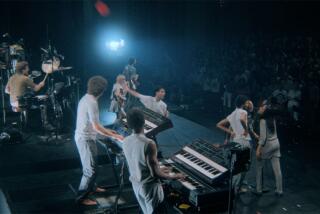At Playboy festival, film vault opens for glimpse of the greats
- Share via
There aren’t a lot of opportunities to both see and hear the music of jazz artists from Stan Kenton and Nat King Cole to Thelonious Monk and Louis Armstrong.
But the Playboy Jazz Festival provides at least one such experience every year via the “Jazz on Film” programs of jazz collector Mark Cantor.
His film clips presentation Thursday night in the Los Angeles County Museum of Art’s Leo S. Bing Theater was a fascinating, three-part excursion reaching across virtually the entire history of jazz.
Part 1, “Swing-to-Bop,” began with a ‘40s performance by the Duke Ellington Orchestra, playing “Cottontail” in an early version of a music video, featuring wildly gymnastic jitterbugging by Whitey’s Lindy Hoppers.
Other selections included a spirited romp through “Just One of Those Things” by the Benny Goodman Quintet (with Terry Gibbs); a briskly swinging “Got a Penny, Benny” by the Nat King Cole Trio; and a dark, modal performance of an unidentified tune by the McCoy Tyner Quartet.
Part 2, “Jazz From Europe,” included selections drawn from a largely unknown vintage archive of material that will be released later this summer in the “Jazz Icons” DVD collection.
The tracks included prime performances by the Count Basie Orchestra (“Back to the Apple”), Art Blakey’s Jazz Messengers (in a soul-stirring rendering of Bobby Timmons’ “Moanin’,” with the composer at the piano), and an extraordinarily up-close look at the Thelonious Monk Quartet (“Epistrophy”).
The program’s final segment, “Jazz Potpourri,” was precisely that, with more Ellington (featuring Ray Nance singing “It Don’t Mean a Thing If It Ain’t Got That Swing”), Stan Kenton (“Eager Beaver”) and a pair of strikingly contemporary numbers from the John Coltrane Quartet (“I Want to Talk About You”) and the Dexter Gordon Quartet (“Ladybird”).
A few of the pieces suffered from production decisions to sync the visual performances with previously recorded tracks.
It might work for Madonna, but it doesn’t particularly work for jazz.
For the most part, however, the film clips offered a live, visceral and compelling view of jazz in action. The program was further enhanced by Cantor’s illuminating between-segments commentary -- the work of a dedicated man who clearly loves both the detail and the artistry of his chosen field of study.
More to Read
The biggest entertainment stories
Get our big stories about Hollywood, film, television, music, arts, culture and more right in your inbox as soon as they publish.
You may occasionally receive promotional content from the Los Angeles Times.









